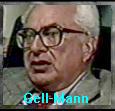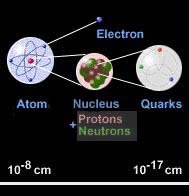Matter Today 1
or
Quarks and neutrinos
or
Quarks and neutrinos
Up until 1964, it was believed that there only
existed three elementary particles making up the atom: the electron, the
proton and the neutron.
However, numerous unstable particles (with a
lifetime of the order of 10-23 seconds)
have been detected, either in cosmic rays, or in the high energy impacts
created in particle accelerators constructed after the 39-45 war.
![]() Particle
accelerators
Particle
accelerators
 These
accelerators, also called colliders, are enormous and very expensive
machines which can reach several tens of kilometers in length. The aim
is to accelerate charged particles (electrons, protons, ions) to speeds
close to that of light!
These
accelerators, also called colliders, are enormous and very expensive
machines which can reach several tens of kilometers in length. The aim
is to accelerate charged particles (electrons, protons, ions) to speeds
close to that of light!
The energy attained by these particles is enormous
(ie their speed) and probe particles are then projected into target particles:
this permits the consequences of the impacts provoked in this way to be
studied. The enormous energy of these impacts can be converted into new
particles. The higher the energy of the collision, the more massive are
these newly created particles and the more information they give physicists
on the ultimate constituants of matter.
Accelerators can currently be of two types:
![]()
![]() Quarks
Quarks
Discovery:
It had become clear, at the start of the 60s,
that the very large number of particles (more than 300) detected in the
colliders had little chance of being elementary.

Set out for the first time in 1964 by Murray
Gell-Mann and independantly by George Zweig, the theory of quarks
progressively established its pedigree and won aclaim as advances corroborated
the theory by experiment; It was not until 1975 that quarks were detected
experimentaly.
The strange name of Quark comes from a roman phrase of James Joyce in "Finnegans Wake": Three Quarks for Muster Mark!:
Quarks are the constituents of nucleons. There
exist two types in ordinary matter.
| up quark (symbol = u) | electric charge Q = +2/3 |
| down quark (symbol = d) | electric charge Q = -1/3 |
Why are these Q charges fractional in the way
that they are? Because nucleons are always made up of 3 quarks:
| NUCLEON: | QUARKS: | CHARGE Q: |
| proton | u + u + d | +2/3+2/3 -1/3 = +1 |
| neutron | u + d + d | +2/3 -1/3 -1/3 = 0 |
The size of a quark is theoretically point sized, but in reality is less than 10-18 m; that is at least a thousand times smaller than the size of a nucleon which is 10-15 m.

Quarks, like nucleons, are fermions of spin J = 1/2 and are joined
by a force called the strong interaction (the same as binds together
nucleons).
Quarks have a unique property: they are incapables of existing alone,
unaccompanied!
It is absolutely impossible to observe a quark in isolation; quarks
cannot aggregate except in two different manners and only therefore give
rise to two families of composite particles:
We thus approach the current understanding of the structure of the nucleus:
2 sorts of quark forming protons and neutrons and 1 electron. In reality,
it lacks one other particle of matter (or fermion) fundamental to our game
of Lego:
![]()
![]() The
neutrino
The
neutrino
This fundamental particle was "invented" in 1930 by Wolfgang Pauli (him again!) to explain the mechanism of Beta radioactivity: a neutron transforms into a proton by emitting an electron (beta ray) and another mysterious particle that the italian physicist Enrico Fermi named in 1933 "neutrino"; which in italian means "little neutron".
It was not until 1956, after a conclusive experiment that Frederick
Reines and Clydes Cowan ![]() showed
evidence for the neutrino. These two scientists installed a neutrino detector
close to a nuclear reactor at Savannah River, in South Carolina.
showed
evidence for the neutrino. These two scientists installed a neutrino detector
close to a nuclear reactor at Savannah River, in South Carolina.
The neutrino has a Q charge of null and it is 50,000 times smaller
than an electron.
Its extremely small mass has only ever been detected on the 5 June
1998 in Japan! The measurement of this mass could be of capital importance
for the destiny of the Universe: According to the current cosmological
model, the universe was born from a gigantic explosion, the Big
Bang. It will from here, continue to dilute indefinitely, unless it
has enough mass to re-contract into a Big Crunch. This missing
mass of the Universe could be found in neutrinos which are very numerous
in the Cosmos.
Such is the way that an infinitesimaly small particle can have an enormous
power over the destiny of the infinitely large!
This discrete particle does not interact with matter very much at all.:
One would need a sheet of lead a light year thick to stop half of the neutrinos
which attempt to traverse it!
Neutrinos are produced abundantly by stars such as our Sun: each second, hundreds of millions of solar neutrinos can pass through the earth and our bodies without suffering the least impact! Hence the extreme difficulty in detecting them...
The neutrino and the electron (light weight particles), are grouped
in the familly of leptons (from the greek "leptos" = light).
The combination of two leptons and two quarks u and d are thus
the building blocks of our world.
| Our matter currently: | |
| QUARKS | UP and DOWN |
| LEPTONS | ELECTRON and NEUTRINO |
Is that all ?
No !
There exists a mirror universe where matter is transformed into anti-matter...